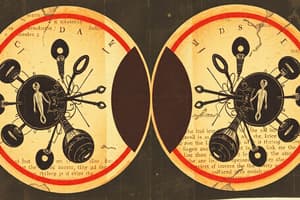Podcast
Questions and Answers
Match the stages of mitosis with their descriptions:
Match the stages of mitosis with their descriptions:
Metaphase = The chromosomes line up across the middle of the cell Prophase = Chromosomes become visible Anaphase = The centromeres split and sister chromatids separate into individual chromosomes Telophase = Nuclear envelope re-forms Interphase = The cell is just living and doing its job
Match the stages of meiosis with their descriptions:
Match the stages of meiosis with their descriptions:
Anaphase 1 = Spindle fibers pull homologous chromosome pairs to opposite sides of the cell Telophase 2 = 4 haploid daughter cells form Interphase = Cells undergo a round of DNA replication Anaphase 2 = Sister chromatids separate from each other at the centromeres Telophase 1 = 2 haploid daughter cells are formed Metaphase 1 = Homologous chromosome pairs randomly line up in the center of the cell Prophase 1 = Crossing over occurs
What type of cells use mitosis as a method of cell division?
What type of cells use mitosis as a method of cell division?
Somatic (body) cells
What type of cells use meiosis as a method of cell division?
What type of cells use meiosis as a method of cell division?
How many daughter cells result from mitosis?
How many daughter cells result from mitosis?
How many daughter cells result from meiosis?
How many daughter cells result from meiosis?
If a diploid cell containing 28 chromosomes undergoes mitosis, how many chromosomes will each daughter cell have?
If a diploid cell containing 28 chromosomes undergoes mitosis, how many chromosomes will each daughter cell have?
If a diploid cell containing 28 chromosomes undergoes meiosis, how many chromosomes will each daughter cell have?
If a diploid cell containing 28 chromosomes undergoes meiosis, how many chromosomes will each daughter cell have?
What do you call the process where the cytoplasm splits and completely separate cells are formed following mitosis and meiosis?
What do you call the process where the cytoplasm splits and completely separate cells are formed following mitosis and meiosis?
Cells produced from mitosis contain two copies of each chromosome.
Cells produced from mitosis contain two copies of each chromosome.
Cells produced in meiosis contain two copies of each chromosome.
Cells produced in meiosis contain two copies of each chromosome.
Flashcards are hidden until you start studying
Study Notes
Stages of Mitosis
- Prophase: Chromosomes become visible as they condense.
- Metaphase: Chromosomes align in the center of the cell, connected by spindle fibers.
- Anaphase: Centromeres split, and sister chromatids separate into individual chromosomes, moving to opposite ends.
- Telophase: Nuclear envelope re-forms around each set of chromosomes, signaling the end of nuclear division.
- Interphase: The cell engages in normal metabolic activities and prepares for division by replicating its DNA.
Stages of Meiosis
- Interphase: The cell undergoes DNA replication before the division process begins.
- Prophase 1: Chromatin condenses into visible chromosomes; crossing over occurs, allowing genetic recombination.
- Metaphase 1: Homologous chromosome pairs randomly line up at the cell's center.
- Anaphase 1: Spindle fibers pull homologous chromosome pairs (tetrads) to opposite sides of the cell.
- Telophase 1: Formation of two haploid daughter cells marks the end of the first meiotic division.
- Anaphase 2: Sister chromatids are separated at the centromeres and move to opposite ends of the cells.
- Telophase 2: Four haploid daughter cells are formed after the completion of meiosis.
Comparing Mitosis and Meiosis
- Mitosis occurs in somatic (body) cells, while meiosis takes place in gametes, contributing to sexual reproduction.
- Mitosis produces 2 daughter cells, whereas meiosis results in 4 daughter cells.
- In mitosis, daughter cells maintain the same chromosome number as the parent cell (e.g., 28 in diploid cells), while meiosis reduces the number by half (14 in haploid cells).
- Mitosis produces diploid cells, containing two copies of each chromosome, while meiosis yields haploid cells with one copy of each chromosome.
- Both processes conclude with cytokinesis, the division of the cytoplasm leading to fully separated cells.
Studying That Suits You
Use AI to generate personalized quizzes and flashcards to suit your learning preferences.





